Are you looking for easy ways to turn on or off startup sound in Windows 10?
When Windows is back in action, it likes to announce it.
This feature is great for people who want Windows to greet them with a jingle every time they turn their PC on. Nevertheless, if you are living with your family, it may not be the best option since the startup noise will most likely disturb everyone around if you do not have earphones plugged in.
Luckily, the startup sound is a customizable feature, and you can modify the settings according to your preferences.
In this guide, we will walk you through some easy ways of enabling and disabling the startup sound on your PC.
Let’s get started.
1. Modify Sound Settings.
If you want to turn on or off startup sound in Windows 10, then the easiest way of doing so is via Windows Settings.
Windows Settings features a Sound Control option that allows the users to customize the settings according to their preferences. However, in some cases the Startup sound feature might be greyed out. If this occurs, move on to the next procedure below.
Here is how you can turn on/off Startup sound in Windows 10:
- Launch Settings window and choose System from the list of options available on your screen.
- Select Sound from the left panel.
- In the right pane under Related Settings, click on Sound Control Panel.
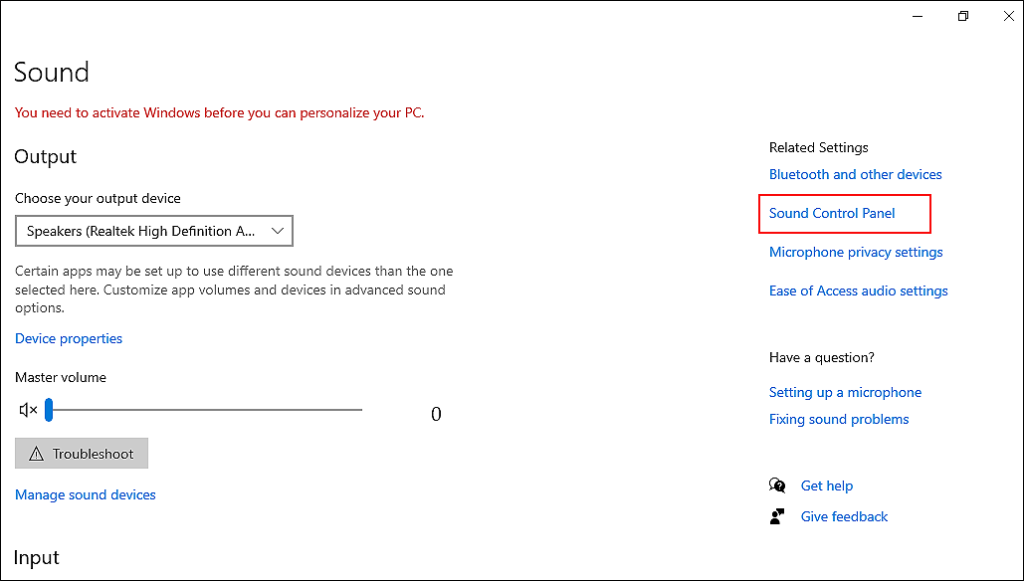
- Go to the Sounds tab and checkmark the Play Windows Startup sound option if you wish the enable the Startup sound.
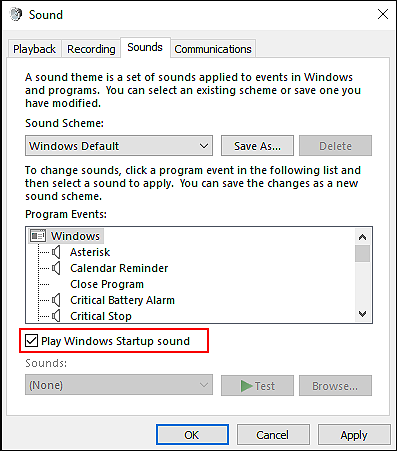
- If you want to disable the Startup sound, uncheck the Play Windows Startup sound option.
- Finally, click on Apply/OK to save the changes.
This should turn On/Off Startup sound in Windows 10.
2. Use the Local Group Policy Editor.
If the Startup sound feature in the Windows Settings was greyed out, then try performing the desired task using the Group Policy Editor.
Group Policy Editor is a Windows feature that gives the users better control over their operating system. Advanced users employ this feature to modify their operating system to meet their needs, and that’s exactly what we will do in this method.
Here is what you need to do:
- Press Windows + R keys simultaneously to open a Run dialogue box.
- In the text field of the dialogue box, type ‘gpedit.msc‘ and hit Enter. Doing so will launch Group Policy Editor on your PC.

- Inside the newly launched window, navigate to the location mentioned below.
Computer Configuration\ Administrative Templates\ System\ Logon\
- Locate Turn off Windows Startup sound policy in the right pane and double-click on it.
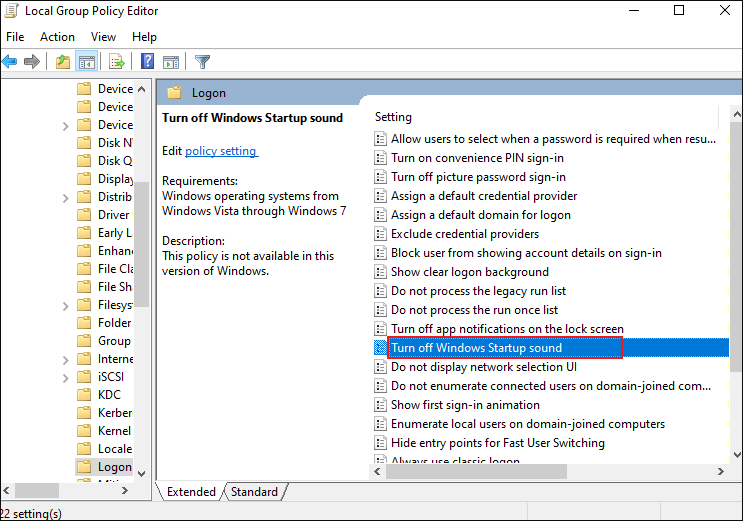
- Now select Enabled/Disabled according to your preferences and click on Apply to save the changes.
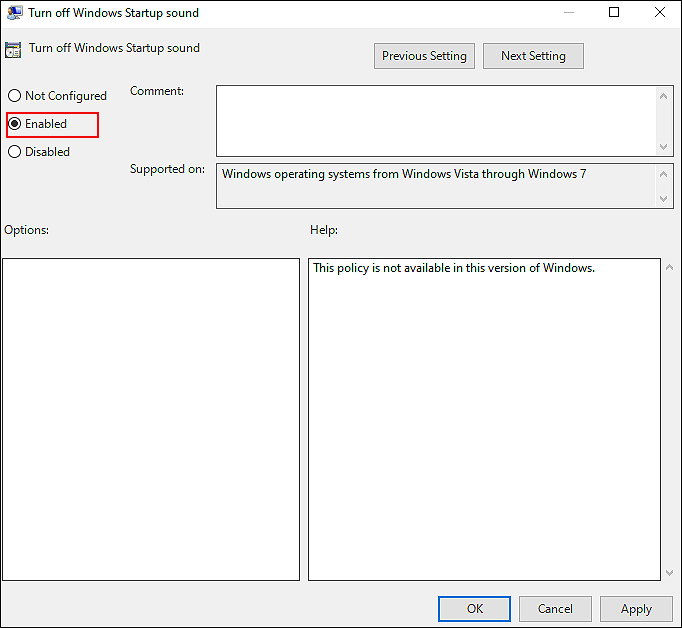
- Check if doing so helped you turn the Startup sound on/off. If it did not, this means that you will have to force update the changes you made in the Group Policy Editor. In this case, proceed with the 7th step.
- Type cmd in the search bar and click on Run as administrator. This will launch elevated Command Prompt on your screen.
- Inside the Command Prompt window, type the command mentioned below and hit Enter to execute it.
gpupdate /force
- Finally, check if this resolved the issue at hand.
Hopefully, modifying the Group policies will do the trick for you.
3. Try Using CleanMyPC.
There is a chance that you could be experiencing a corruption error in the system if our instructions are not working for you.
If this scenario is applicable, you should first remove the corrupt files and then follow the methods we have described. This procedure is not as tedious or complex as it sounds, and using a PC cleaner to remove junk files can help you save both your time and energy.
If you’re unsure of which PC cleaner to choose, we recommend CleanMyPC.

CleanMyPC is one of the most efficient PC cleaners in the market, and can resolve almost all your PC-related problems, including junk files, slow performance, and even online privacy concerns. This cleaner includes a wide variety of tools you can use to maintain and repair your computer’s system. Moreover, it is relatively simple to use, so if you’re new to using a cleaner, you’ll be just fine.
If this is something your computer needs, then install CleanMyPC now!
4. Use Windows Registry.
Another easy way to turn the Startup sound on/off in Windows 10 is by making changes in the Windows Registry.
Windows Registry, much like the Group Policy Editor, enables users to tweak their Windows settings to have a more personalized experience.
Should you choose to proceed in this manner, we recommend that you take extra care while performing the steps since even a slight mistake may cause serious issues with your PC.
Here is all that you need to do:
- Open a Run dialogue box by pressing Windows + R keys simultaneously.
- Type ‘regedit‘ in the text field of the dialogue box and hit Enter. Doing so will launch Windows Registry on your PC.
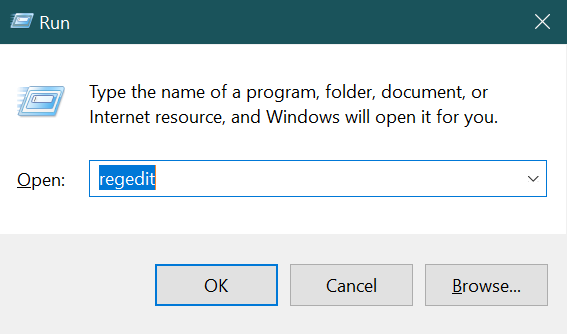
- Inside the Registry Editor, navigate to the location mentioned below.
HKEY_CURRENT_USER\Software\Microsoft\Windows\CurrentVersion\Policies\System
- In the right pane, right-click anywhere and select the New > DWORD (32-bit) Value option.
- Rename this newly created value as DisableStartupSound.
- Double-click on this value and if you want to disable the Startup sound, type 1 under Value data.
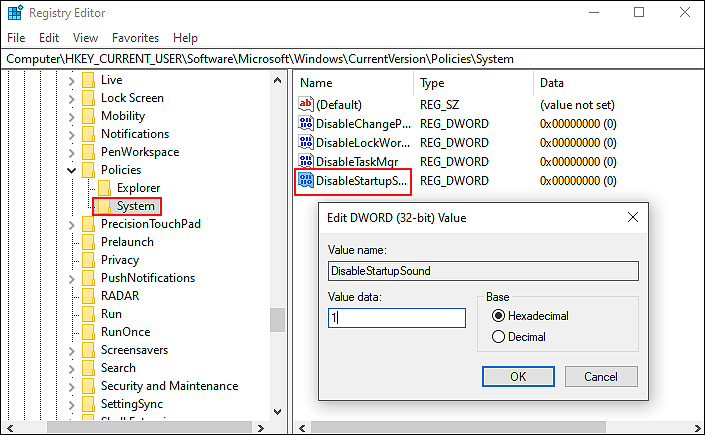
- In case you want to enable the sound, type 0 under Value data.
- Finally, restart your PC.
As simple as that!
Windows Registry will help you turn on or off Startup sound in Windows 10 without any issues.
This brings us to the end of our guide on turning the startup sound on or off in Windows 10. We tried walking you through all the steps in detail and hope that one of the methods mentioned above did the trick for you. In case you still have any confusion about the methods, please let us know in the comment section below!
If this guide helped you, please share it. 🙂





